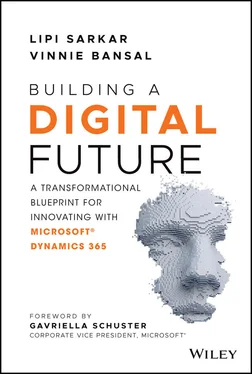There is a growing list of start-ups with unicorn status (start-ups valued at over a billion dollars or more), and these businesses build by disrupting traditional businesses through technology (e.g., WeWork, Airbnb, WeChat). As referred to in Figure 1.1, businesses need to innovate and transform business models and also transform the technology ecosystems.
Phases of Digital Transformation
It is clear that businesses should either disrupt or be disrupted, and there is no single solution that fits all for the successful digital transformation; the best results are achieved through a gradual strategic and holistic progression across the business. In order to disrupt or avoid being disrupted, it is essential to understand three maturity model and stages of digital transformation ( Figure 1.2):
Stage 1: Digital Assets/Optimize existing IT. Move the existing infrastructure to the cloud and experiment with new non-core applications in the cloud to save IT operating costs.
Stage 2: Digital Experience—Optimize the current business model. Move your core business data and processes into a cloud-based business application to achieve operational excellence. FIGURE 1.2Three Stages of Digital JourneySource: Kevin Saunders, Three phases of Digital Journey, www.strategymeetsaction.com/digital-insurer/
Stage 3: Digital Transformation—Create new business models. Use the knowledge of your cloud-based infrastructure, processes, and data to create new offers and sales models.
Digital technology connects people and machines to provide an experience that no one envisaged a decade back, like watching a movie at home, buying a car online, banking services without visiting a bank, to name a few. This is all possible due to advancement in technology and quest to provide a better customer experience by businesses—by continuously finding the right solution and investing in technology, which is a continuous journey!
The COVID-19 pandemic has challenged the human race and businesses like never before; there is competition for survival, whether it is for people or businesses, as the pandemic has tested companies in 2020 for their existence irrespective of their size and sector.
Countries went into lockdown for the first time in modern history. All non-essential businesses were shut. This has put IT/Digital in the spotlight like never before. Some businesses could not operate due to lockdown, for example, airlines, travel, and hospitality, while others thrived, like Amazon and PayPal. However, other retail companies without digital DNA found it challenging to survive as they could not function due to their lack of digital presence.
Primark is one of the biggest upscale apparel chains in Europe, but during the COVID-19 pandemic it was in the news and social media for its $650 million monthly revenue down to $0 due to lockdowns across the world. As Primark did not have an online store, the impact has been harder than for other retailers and it had to close down 375 stores within 12 days.
Like Primark, many other businesses will be adapting to shifts in customer behavior, and consumption patterns will guide many aspects of how business models get transformed post-COVID-19. It is time to realign business models!
Besides the impact of the pandemic accelerating digitization for some industries, some other trends will continue to play out:
Rapid introduction of digital operating models.
Digitizing value chains.
Ever-increasing power of social media.
Connected customer experience.
Application of artificial intelligence and machine learning.
Rise of privacy and regulations.
Cybersecurity and threat intelligence, which is fuelling business performance.
Digital Transformation with Dynamics 365
Digital transformation does not come in a box or a cloud. We are in the fourth industrial revolution and it is an exciting time. We are experiencing mass adoption of digital technologies and it is evolving faster than ever before, which is becoming challenging for businesses to keep up with the pace while dealing with scarcity of skilled resources.
While the digital transformation of industries will be profound, we must keep in mind that it will have a wider economic and social impact, too, as we have seen with previous revolutions driven by steam and coal and electricity and computers.
It is time to reassess your organization's ways of working by reviewing internal capability, resource utilization, cost efficiency, and collaborative platform that can be used to drive the operational efficiencies, reduce costs, and eventually help you to transform your operation.
We will cover the capabilities of transforming your business in Chapter 2and discuss the power of the Microsoft platform in Chapter 3. Digital transformation cannot happen overnight. We need to transform the mindset of how we are currently doing business, people who are key to the business, and how we can prepare the program for digital transformation. We will cover this in Chapters 4and 5. We will dive deeply into organizational change management for Microsoft Dynamics 365 and DX in Chapter 6.
Digital transformation involves using digital technologies to shape the process and to become more efficient and/or effective, and to transform the services into something significantly better. We will emphasize the fundamentals of executing a successful Dynamics 365 project in Chapter 7.
Some of the challenges will require a revolution in skills, and while your business is not running at full capacity (due to the lockdown), you have the opportunity to redeploy some of your team members. This does not need to be deeply technical (you can hire the technical power) but think about those who can work across different departments or business units. You have probably already witnessed this over the past few months where some of your talents stepped up and made things happen under the new circumstances. Giving them an opportunity to be a part of a new direction for your organization will make a world of difference for most millennials and will help you to attract and retain staff. In your new digital culture, roles will become more flexible. Some of the roles will be more permanent in order to provide structure and technical guidance, but your new digital culture with a continuous flow of initiatives will create new roles that evolve with its needs and pace. We will focus on key roles of people in the digital transformation and how we can empower them in Chapter 8.
The Microsoft Dynamics 365 platform offers powerful tools like Workflow, Power Platform, Cloud and Cloud automation tools, all of which help to automate time-consuming tasks. The team can also utilize robust Internet of Things (IoT), artificial intelligence (AI), and machine learning functionality best on internal teams’ capability and a vision for expansion on team capability by including some specific skills such as:
Software engineers, cloud computing specialists, and product managers remain key roles for companies seeking to roll out new products and services. DevOps leaders galvanize software development by merging development with operations, enabling companies to continuously iterate software to speed delivery.
Data scientists and data architects are also in high demand, as companies seek to glean insights out of vast troves of data, and transformations lean increasingly on machine learning and artificial intelligence.
In addition, IT departments supporting business-wide transformations also require UX designers, digital trainers, writers, conversational brand strategists, forensic analysts, ethics compliance managers, and digital and workplace technology managers.
It is evident that businesses and leaders need to accelerate digital transformation to survive and thrive in the current economic situations. The key questions that keep the leaders and businesses thinking are where to start, who are the key stakeholders, and how to get their buy-in for the necessary support and budgets?
Читать дальше












